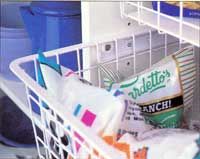A successfully organized kitchen pantry depends on the same principles as all the other areas in your home that are to be organized. They all combat the same problem: The size of the space doesn't match the amount of storage needed. The regular occupants of a kitchen pantry need to be regulated through the organizing system you use and through the size of the space they inhabit. For instance, when canned goods are stored willy-nilly on one shelf or another, it's no wonder you can't keep tabs on them. The pantry must be organized to ultimately create many smaller sections of space. This will keep all the items in a pantry -- canned goods, spices, chips, dishes, pasta, flour, and the like -- more visible, accessible, and controlled.
Items should be kept separate: soups from boxed cereals, spices from pastas, and so on. Each distinct and different category should be treated as a separate entity. You might try placing the items on the shelves in alphabetical order: all appetizers at one end and finishing with vegetables at the opposite end.
Advertisement
As for storing the items once they have been organized, there are many different options on the market.
Basket Drawers: As you contemplate various methods for reorganizing the space in the pantry you'll probably review the "slide-out" type of basket drawer. These types of baskets are definite space savers and can hold plenty of items. The bottom of the baskets may need to have a piece of Lucite, cardboard, or plywood to provide a level surface. The slide-out drawer is useful for bagged or bulky items such as pasta or chips. Smaller, shallower baskets may provide better access for smaller containers of condiments or spices.
Stackable Bins: You might want to consider adding some stackable bins to the pantry, but they are advisable only for storing such bulk items as potatoes or dry beans. It's fine to reach into the bin and grab a handful of potatoes, but this would hardly be acceptable if you wanted crackers and pulled out a box of cake mix instead! These bins are a good way to use the pantry's floor space. Stackable shelving units may also work well in unused floor space. If you have enough space of the correct shape, the floor area of the pantry may also be the perfect spot for a recycling center or a miniature wine cellar.
Shelves and Racks: An innovative variation is the use of the corner for shelves. As in any closet space, the corner is not very useful. But in this case the shelving turns the corner into a productive, spacious place for many items. Divide existing shelf space in the pantry. This will double the amount of usable shelf space and make that shelf space a more manageable and functional storage area.

Pantries, like laundry rooms, often serve double duty in the never ending search for storage space. There are various ways and means to perform this extra duty properly and efficiently. Some racks fit snugly and compactly to the side walls of a pantry, the inside of a cabinet door, or underneath a shelf. Examine the wide variety of racks that are available and decide if any meet your needs.
The pantry is also often the final resting place for extra sets of silverware, china, or stemware. The space inside the pantry can hold these items if you use various types of racks available at many stores. It's also possible the pantry could supply the only storage area for cleaning supplies. If that is the case, an all-in-one portable cleaning cart is a prime example of effective, efficient use of space.
And what if you have no pantry at all? You can create your own by either purchasing a floor model unit or improvising one from an existing cabinet.
Though many items may compete for pantry space, you can fit them all through wise planning and judicious compromises. Keeping a neat pantry is simple, as long as you know which containers to employ and the range of storage options available to you.
©Publications International, Ltd.
Advertisement
